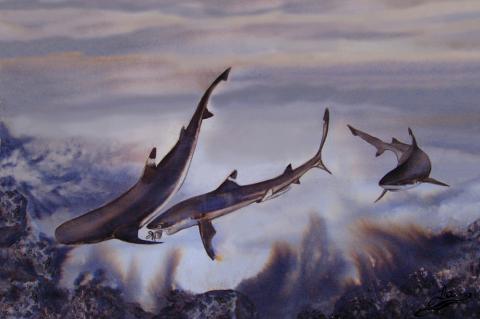X-Ray Mag #52
Diving Spain's Costa Brava; Honduras' Roatan; Micronesia's Kosrae & Pohnpei; Diving Gulen, Norwegian fjord; Kids Scuba Malaysia Mabul-Sipadan Camp; Jim Hellemn profile; Why scientific diving safer; Diving the Mesoamerican Barrier Reef; Dive fitness: The Clock; Tech: 10 tips on going pro; When sharks really attack; All about mirrorless cameras lenses; Amanda Richardson portfolio; Plus news and discoveries, equipment and training news, books and media, underwater photo and video equipment, turtle news, shark tales, whale tales and much more...
Main features in this issue include:
10 Tips On Going Pro
Becoming a good technical diver means starting with the solid basics. There is no magic! But let’s take a look at several things in general...
1. Excellent trim.
Amanda Richardson Portfolio
Few fine artists have been able to marry the sensuous nature of luxurious textiles with the luscious diversity of underwater realm as well as Amanda Richardson.
In Richardson’s works, there is a strong sense of place. She left Cornwall in 1986 and spent ten years in the Pacific Northwest of the United States.
Cala Joncols, Costa Brava
When people from the United States go on a European vacation, diving is usually not on the agenda. But the Costa Brava area on the northeastern coast of Spain offers some interesting diving. It might not be as colorful as the Red Sea or Indonesia, but add on the cultural experience, and it is worth a visit.
Barcelona
Choosing Mirrorless Cameras for UW Photography
While the number of camera manufacturers with horses in the mirrorless race has now reached critical mass with the recent entrance of Canon and its EOS-M, and the earlier entrance of Nikon with the J1 and V1 cameras, the number of models available has grown even more. However, for underwater photography the choices narrow somewhat and the early entrants in the mirrorless race, Olympus, Panasonic and Sony, are very much in the lead.
This is because of two key factors—the availability of lenses suitable for underwater photography and the availability of housings to put the cameras in.
Kosrae & Pohnpei
The idea of diving Micronesia forms dreams of warm, crystal blue waters with big animals, wrecks and mantas. Most divers probably include it on their dream dive destination list, or, those who’ve been there eagerly recommend it to dive buddies and reminisce about sharks, mantas and the beauty of these wonderful islands.
I had returned from my second trip to Palau and, like the first trip, it was amazing. I was anything but disappointed with ten female grey reef sharks on one dive at Ulong Channel, ripping currents at Blue Corner and the curious mysteries of unidentified Japanese World War II wrecks.
The Clock — Extend dive time with physical fitness
Tick tock tick tock. Have you ever heard someone say, “There goes 15 minutes of my life I will never get back?” While there are many different philosophies and applications of time, most divers don’t want to waste it. Instead, divers carefully invest some of their precious time, energy and money planning and preparing for their ideal SCUBA experience.
In fact, divers seem to have their own built-in water clocks pouring over dive logs, recording time in and time out of the water, bottom time and surface intervals, and adding up the flow of minutes as a measure of experience.
When Sharks Really Attack
Anyone who has faced an agitated shark has felt the power of communication through body language. The response is so immediate and so physical, that emotion, expressing through body language, is revealed as an important medium of pre-vocal communication among animals.
I had some curious experiences with blackfin reef sharks (Carcharhinus melanopterus) while observing them in Tahiti’s lagoons, where they were easy to watch in two meters of water, and sneaked for years through the lagoons and depths off the island to learn what they do when no one is looking.
Why is scientific diving safer?
Scientific diving appears to be one of the safer forms of diving, a recent study of incidences of decompression illness over ten years has found. This safety seems to be facilitated by a combination of relatively high levels of training and oversight, the predominance of shallow, no-decompression diving and, possibly, low peer or institutional pressure to complete dives under less than optimal circumstances.
One of the authors, diving physiologist Dr Neal W Pollock, said that whilst the AAUS (www.aaus.org) was not capturing data from all scientific dives conducted globally, this report was a reasonable snapshot of what is happening in the scientific diving community.









